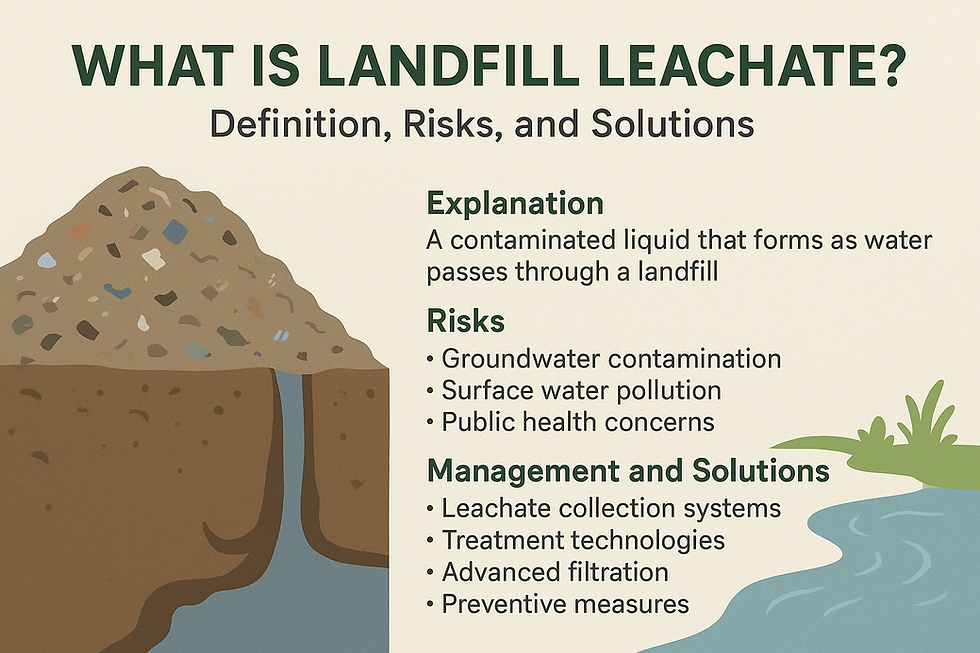Are Landfills Polluting the Earth?
- ierminstituteseo
- Sep 23
- 3 min read
When we think about pollution, we often imagine smoke rising from factories or traffic jams filling the air with fumes. But there is another silent polluter that many people overlook—landfills. Across the world, millions of tons of waste end up in landfills every year. While these sites are designed to store garbage safely, the reality is more concerning. Let’s explore whether landfills are polluting the Earth and what their long-term impacts look like.

How are Landfills Affecting the Environment?
The short answer is: landfills affect the environment in multiple ways. From greenhouse gas emissions to contamination of soil and groundwater, the problems are more serious than they appear. Landfills don’t just store waste—they slowly release harmful substances into our natural surroundings.
Air Pollution and Climate Change
One of the biggest issues with landfills is the release of methane gas. As organic waste like food scraps and paper break down without oxygen, they produce methane, a greenhouse gas that is far more powerful than carbon dioxide. According to environmental studies, methane from landfills contributes heavily to global warming. This is why landfills are often referred to as “climate time bombs.”
Soil and Water Contamination
Another major concern is the leakage of toxic chemicals. Waste doesn’t just vanish once buried. Over time, harmful liquids known as leachate seep into the soil. This liquid can contain chemicals from plastics, metals, electronics, and other hazardous waste. If not properly managed, it can enter groundwater supplies, affecting rivers, lakes, and even drinking water. Communities near landfills are at higher risk of facing contaminated water sources, which can impact both human health and local wildlife.
Impact on Ecosystems
Landfills don’t exist in isolation. Birds, insects, and animals are often attracted to these sites because of the food waste. Unfortunately, consuming toxic or plastic waste harms them. In addition, the loss of land to build massive landfill sites destroys natural habitats, leading to biodiversity loss. This creates an imbalance in ecosystems that we all depend on.
Health Risks for Humans
Living near a landfill is not just unpleasant—it can be dangerous. Studies show that people in nearby areas are more likely to experience respiratory problems, skin irritations, and other health issues due to landfill emissions. In some cases, long-term exposure has been linked to serious conditions like cancer.
Are Landfills the Only Option?
The good news is that alternatives exist. Many cities are turning toward recycling, composting, and waste-to-energy solutions to reduce the pressure on landfills. Public awareness and responsible waste management can play a big role in minimizing pollution. If households and businesses reduce single-use plastics, recycle properly, and support eco-friendly policies, the need for landfills can be drastically reduced.
IE-RM Approach (Inform–Educate–Reduce–Manage)
To tackle the landfill problem, an IE-RM strategy can help:
Inform people about the dangers of landfills.
Educate communities on waste reduction and recycling.
Reduce overall waste production through sustainable lifestyle choices.
Manage existing landfills with modern technology to limit environmental damage.
Final Thoughts
So, are landfills polluting the Earth? The answer is yes. From poisoning our soil and water to fueling climate change, landfills are one of the biggest hidden threats to our environment. The question, “How are Landfills Affecting the Environment”, leads us to an urgent reality: unless we adopt better waste management practices, the pollution caused by landfills will only get worse.
By choosing to recycle, compost, and support sustainable waste management policies, we can reduce the damage. Protecting the Earth is not just about cutting emissions or planting trees—it’s also about rethinking the way we handle our trash.



Comments